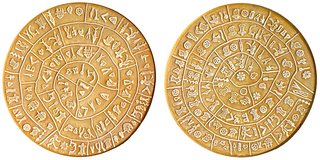Phaistos Disc
|
|
The Phaistos Disc (Phaestos Disc, Festos Disc) is a curious archeological find, most likely dating from about 1700 BC. Its purpose and meaning, and even its original geographical place of manufacture, remain unknown, making it one of the most famous mysteries of archaeology.

| Contents |
Discovery
The Phaistos Disc was discovered in the basement of room XL-101 of the Minoan palace-site of Phaistos, near Hagia Triada, on the south coast of Crete. Italian archaeologist Luigi Pernier recovered this remarkably intact "dish", about 15 cm in diameter and uniformly just over 1 cm thick, on July 3 1908.
Archaeological context
Luigi Pernier discovered the disc during his excavation of the first Minoan palace. It was found in an underground "temple depository". These basement cells, only accessible from above, were neatly covered with a layer of fine plaster. Their context was poor in precious artifacts but rich in black earth and ashes, mixed with burnt bovine bones. A few inches north, and about twenty inches above the floor, linear A tablet PH-1 was also found. The site apparently collapsed as a result of the explosive eruption of the Santorini volcano that affected large parts of the Mediterranean region ca. 1628 BC.
Physical description
| Missing image Diskos.von.Phaistos_Seite.A_11-Aug-2004_asb_PICT3371.JPG Side A (Original) | Missing image Diskos.von.Phaistos_Seite.B_11-Aug-2004_asb_PICT3370.JPG Side B (Original) |
The inscription was made by pressing pre-formed hieroglyphic "seals" into the soft clay, in a clockwise sequence spiralling towards the disc's center. It was then baked at high temperature. There are a total of 241 figures on the disc. Many of the 45 different glyphs represent easily identifiable every-day things, including human figures, fish, birds, insects, plants, a boat, a shield, a staff, etc. In addition to these, there is a small diagonal line that occurs underneath the final sign in a group a total of 18 times. (These are not visible in the schematic representation at the top of this article, but most can be seen quite clearly in the photographs). The disk shows traces of corrections made by the scribe in several places. This unique object is now on display at the archaeological museum of Heraklion in Crete, Greece.
The Text
Although there is no official Unicode encoding for the symbols on the disk, the ConScript Unicode Registry (http://www.evertype.com/standards/csur/) has assigned a block of the Unicode Private Use Area to be used for the script. Two fonts include support for this area; Code2000 (http://home.att.net/~jameskass/) and Everson Mono Phaistos (http://www.evertype.com/standards/csur/phaistos-sample.html). The text on the disk is given on the second of these links; you can read that text if you have either of them installed.
Attempted decipherment
A great deal of speculation developed around the disc during the 20th century. The Phaistos Disc captured the imagination of amateur archeologists. Alas, some of the more fanciful interpretations of its meaning are living classics of pseudoarchaeology.
Many attempts have been made to decipher the code behind the disc's glyphs. Historically, almost anything has been proposed, including prayers, a narrative or an adventure story, a "psalterion", a call to arms, and a geometric theorem.
Uniqueness
The uniqueness of this archeological object is contested by at least two other apparently related specimens - a votive double axe found by Spyridon Marinatos in the Arkalohori Cave, Crete, and a fragment of a smaller clay disk, found at Vladikavkaz, North Ossetia. However, the first contains only superficially similar hieroglyphics, and the second, interesting as it might prove, disappeared mysteriously. So far, the Phaistos disk remains a hapax.
Selected bibliography
- Louis Godart, The Phaistos Disc - the enigma of an Aegean script, ITANOS Publications, 1995.
- Thomas Balistier, The Phaistos Disc - an account of its unsolved mystery, Verlag Thomas Balistier, 2000.
- Yves Duhoux, Le disque de phaestos, Leuven, 1977.
- John Chadwick, The Decipherment of Linear B, Cambridge University Press, 1958.
- Jean Faucounau, "Le déchiffrement du Disque de Phaistos" & "Les Proto-Ioniens.." (Paris, 1999 & 2001).
- Torsten Timm, Der Diskos von Phaistos Fremdeinfluss oder kretisches Erbe?, BoD, 2005. ISBN 3-8334-2451-6
See also
External links
General
- http://www.millennia.org/phaistos.html (A short article)
- http://www.world-mysteries.com/sar_9.htm (A article on a site about strange ancient artefacts)
- http://www.interkriti.org/culture/festos/phaist2.htm (The symbols)
- http://disque.phaistos.free.fr/phaistos.htm (French site)
Decipherment claims
Several decipherment claims exist. Here are listed only those which attracted some citeable discussion.
- http://users.otenet.gr/~svoronan/phaistos.htm (Overview of attempts to decipher the Phaistos Disc)
- http://digilander.libero.it/marcoguidocorsini/rada.htm (An interpretation as Greek inscription)
- http://www.openweb.ru/rongo/disk.htm (An interpretation as Slavonic inscription)
- http://www.iris-ward.com/DISK/2014-DISK.htm (An interpretation as Greek inscription)
- http://home.att.net/~phaistosdisk/ph.html (An interpretation as Semitic inscription)
- http://www.kereti.de/indexEngl.html (Compared with Linear A)
New Age speculations
- http://www.crystalinks.com/phaistosdisc.html (Game Board)
de:Diskos von Phaistós
el:Δίσκος της Φαιστού
fr:Disque de Phaistos
it:Disco di Festo
nl:Schijf van Phaistos
pl:Dysk z Fajstos
ro:Discul din Phaistos
